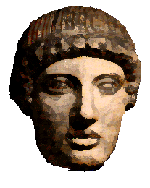Reviews
Aeschylus' Seven Against Thebes
Sette Contro Tebe di Eschilo
Teatro Greco, Siracusa, May 2005
Directed by Jean Pierre Vincent, performed in Italian
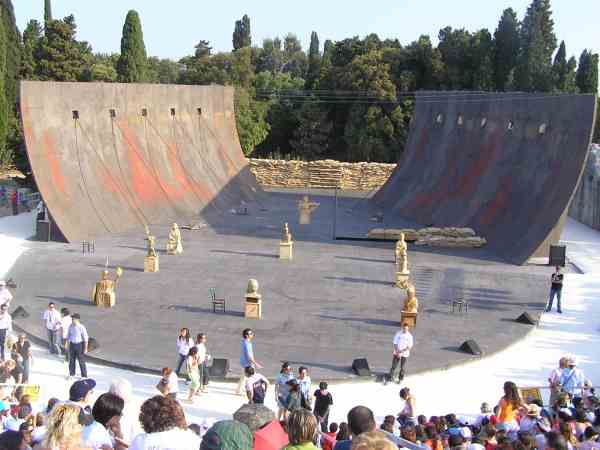
I chose a seat much higher up the cavea, where a wooden superstructure covered the eroded original stone, and was consequently much more comfortable than I was for Antigone. Surprisingly, the overall view is much more satisfactory from higher up, as the circle appears less distorted. I was rather surprised to see that a completely new set had been installed: gone was the white circle and the brooding Cycladic figures; in had come a dark grey circle and two huge structures which seemed to suggest a skateboard arena for Titans. A selection of gods and goddesses formed a square within the circle: the set was completed with three modern chairs. As can be seen, the long shadows produced an important visual effect that would have been very difficult to achieve with stage lighting in an indoor theatre (speaking as a one-time lighting designer!). The Septem was the last play of a trilogy, and the atmosphere of an evening at the end of a long hot day was superbly evoked.
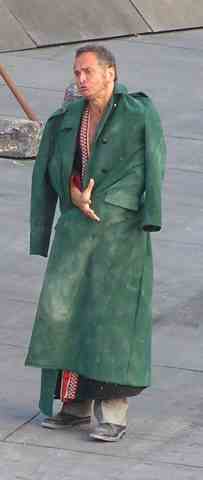 Eteocles was not a young man: a battle-weary veteran in a long greeny blue greatcoat that might once have belonged to Goering rescued from an Oxfam shop. Maybe Antony or, better, Titus Andronicus: you get the picture. But he soon revealed that, like Creon in the Antigone I saw yesterday (yes, I know I was meant to see them the other way round!), he regarded acting as akin to motor-racing: full throttle immediately, and keep up the revs at all costs thereafter.
Eteocles was not a young man: a battle-weary veteran in a long greeny blue greatcoat that might once have belonged to Goering rescued from an Oxfam shop. Maybe Antony or, better, Titus Andronicus: you get the picture. But he soon revealed that, like Creon in the Antigone I saw yesterday (yes, I know I was meant to see them the other way round!), he regarded acting as akin to motor-racing: full throttle immediately, and keep up the revs at all costs thereafter.
The chorus were closer in number to their ancient predecessors - and filled the orchestra not with weight of numbers as in Antigone, but by moving rapidly about, forming and reforming into smaller groupings. They were dressed in theatrical "gypsy" mode - perhaps from an old production of Il Trovatore - obviously though we were intended to think of Bosnia or Afghanistan. As usual, they spoke as individuals - they were after all costumed as individuals: the rich lady magnificent in pink satin and the pauper in rags and headscarf. It was effective, but we lacked the collective voice to stand up to Eteocles: it was as if he was merely being irritated by a swarm of brightly coloured insects. And, in fact, his major tone was, like Creon's, that of a very bad-tempered man; again reminiscent of new comedy rather than of tragedy.
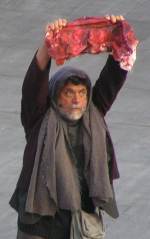 The messenger's first speech was helped by a gruesome bloodstained rag; his long speeches about the enemy champions were delivered with the visual help of a large map, and were strangely compelling: the six Theban champions were seen in silhouette upstage against a background of sandbags; each disappeared with a drum roll as he was named and dispatched to the battle.
The messenger's first speech was helped by a gruesome bloodstained rag; his long speeches about the enemy champions were delivered with the visual help of a large map, and were strangely compelling: the six Theban champions were seen in silhouette upstage against a background of sandbags; each disappeared with a drum roll as he was named and dispatched to the battle.
After the battle, the bodies were brought on downstage - a gory spectacle on which the play originally almost certainly ended. In performance the scene with Antigone and Ismene arguing over the burial seemed ridiculously irrelevant, far more so even than it does when reading the play. It could possibly be justified here in Syracuse; the first play of a pair, it was preparing a modern audience for Antigone - but since it was in fact the last play in its original trilogy it is an unnecessary appendix crying out for surgery.
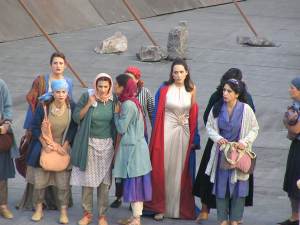 |
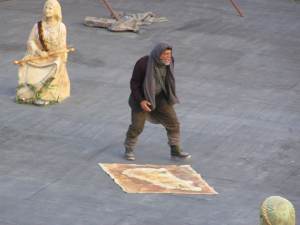 |
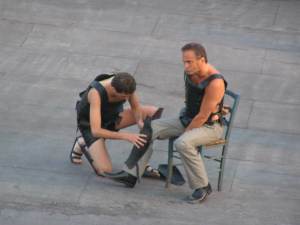 |
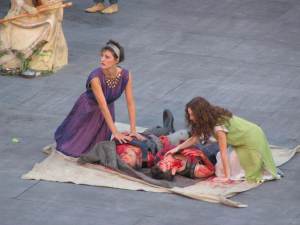 |

